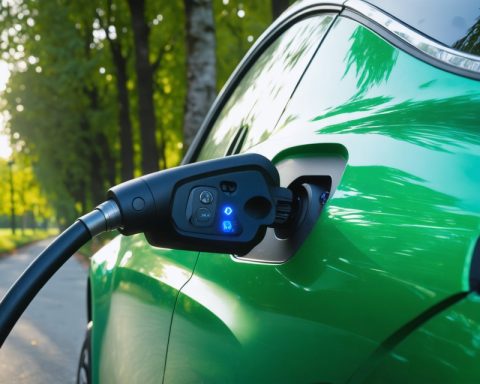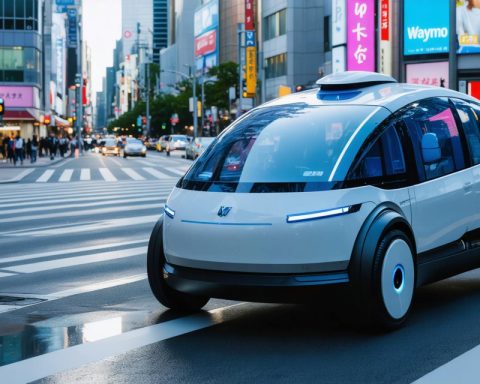- The electrification era ushers in challenges for profitability in the electric vehicle (EV) market.
- Tesla, BYD, Li Auto, and Series Group are the few brands achieving profitability by 2024.
- Vertical integration plays a key role in achieving superior operating margins, as seen with Tesla and BYD.
- Chinese startups like Zeekr, Xpeng, and Leapmotor are making strides, though full profitability remains elusive.
- Nio, Polestar, and Rivian continue to struggle with significant financial challenges.
- Price wars and competition maintain pressure on Tesla’s slim profit margins.
- Lucid, despite heavy losses, is sustained by Saudi investments amidst tough economic conditions.
- The future of EVs is defined by innovation in supply chain control and financial management.
A glinting promise of a cleaner future glistens on the horizon, electrification driving us forward like a beacon. Yet, amid the dazzling allure of electric vehicles, the race for profitability proves treacherous. Despite a surge in EV fascination, only a handful of brands have hurdled the profitability barrier, with Tesla, BYD, Li Auto, and a lesser-known Series Group emerging triumphant in 2024.
Fresh insights from Rho Motion draw attention to a stark reality: mass adoption doesn’t always translate to financial gain. Tesla, the trailblazer, achieved a respectable 7.2% operating margin. Close on their heels, BYD notched a 6.4% margin, with whispers in industry circles suggesting their upward trajectory might soon see them surpassing Tesla in the profitability stakes.
In this economic landscape, a fascinating tale unfolds. While Tesla’s margins have slipped from their peaks, BYD is climbing steadily. The backdrop for this profitability story is a proven strategy: vertical integration. Brands like Tesla and BYD wield this model to perfection, crafting everything from batteries to software in their own backyards. This approach trims costs, boosts efficiencies, and emerges as a decisive edge in a fiercely competitive market.
In China, a hive of innovation, startups are clawing their way up the profitability ladder. Zeekr, under Geely’s expansive umbrella, recorded a -8.5% margin—an improvement, though the peak remains distant. Xpeng and Leapmotor have made significant strides, dramatically cutting their losses and hinting at a positive turn. Yet, others falter. Nio’s margin lingers around -30%, while Polestar and Rivian still wade through their financial quagmires.
One tale of caution and intrigue is that of Lucid. Battling staggering operating losses of -374%, the brand remains in the race, buoyed by Saudi investment—a lifeline in the harsh realities of automotive economics.
As Tesla stands as the lone non-Chinese brand in profitability’s beacon, the landscape of EV rivalry paints a volatile picture. Price wars are chiseling away at margins, testing resilience. With competitors snapping at its heels and holding fast to razor-thin margins, Tesla faces a relentless test of its industry leadership.
In this electrifying chase, the take-home is clear: controlling the supply chain is not just about making cars; it’s about crafting a future. As EV makers accelerate into tomorrow, the path is not just paved with batteries and screens but with the grit of financial dexterity and innovative foresight. The race for green gold is on—and the swift, adaptable, and innovative will be the ones who turn the key to the future.
Can Electric Vehicles Deliver on Their Promise of Profitability?
The electric vehicle (EV) industry, often heralded as a major step toward sustainability and a cleaner future, is facing a key challenge: profitability. While consumer interest and adoption of EVs have surged, turning this interest into profits remains elusive for many brands. By observing industry giants such as Tesla, BYD, and a handful of emerging Chinese auto manufacturers, we can analyze what works and what obstacles remain.
How Vertical Integration Drives Profitability
An essential strategy for leading EV manufacturers is vertical integration. Tesla and BYD have capitalized on this model by controlling nearly every aspect of their supply chain — from battery production to software development. This comprehensive control has proven to minimize costs and maximize efficiency, providing them with an undeniable competitive edge. Tesla’s operating margin stands at an impressive 7.2%, while BYD’s is at 6.4% and climbing, indicating that this approach is indeed profitable.
How-To Steps for Companies Considering Vertical Integration:
1. Assess Your Core Competencies: Identify the key components of your product where you can achieve a competitive edge.
2. Invest in Technology and Human Resources: Ensure that you have the technology and workforce to support in-house production.
3. Secure Partnerships Where Necessary: While in-house is beneficial, strategic partnerships (e.g., raw materials) are sometimes more cost-effective.
4. Think Long-Term: Understand that vertical integration requires upfront investment and a long-term strategy.
Market Forecasts and Industry Trends
According to market analysis by Rho Motion, the electric vehicle market is projected to continue growing globally, particularly in China, where innovation is at its peak. Brands like Xpeng and Leapmotor are making significant strides by reducing losses, signaling a potential shift towards profitability. However, the industry also faces challenges such as fluctuating raw material costs and political factors impacting supply chains.
Reviews & Comparisons: Who’s Leading the Charge?
– Tesla: As the most well-known player, Tesla leads in terms of brand recognition and innovation. Despite shrinking margins, Tesla’s focus on innovation keeps it at the forefront.
– BYD: With a promising upward trajectory, BYD’s approach to vertical integration rivals Tesla’s, and experts predict it may soon surpass Tesla in profitability.
– Other Chinese Brands: Xpeng and Leapmotor are making progress, while Nio and others like Polestar and Rivian continue to wrestle with low or negative margins.
Controversies & Limitations
The industry is not without its controversies. For example, price wars in the EV market are putting pressure on margins across the board. Additionally, the environmental impact of battery production and disposal remains a concern. Moreover, as demonstrated by Lucid’s staggering losses of -374%, high operating costs can be a significant barrier to profitability.
Security & Sustainability
From a security standpoint, the focus is on tackling cybersecurity threats that could exploit the increasing connectivity of EVs. Sustainability remains a priority, with companies exploring more eco-friendly materials and recycling options for batteries.
Insights & Predictions
– Supply Chain Innovations: Expect new technologies and partnerships focusing on enhancing supply chain security and resilience.
– Market Consolidation: Smaller, less profitable firms may face acquisition or exit the market entirely, leading to consolidation.
– Focus on Software: As software becomes a bigger part of EV functionality, focus will likely shift towards in-house development and innovation.
Pros & Cons Overview
Pros:
– Potential for significant long-term profitability.
– Environmental benefit over traditional vehicles.
– Rising customer demand for green technology.
Cons:
– High initial investment and operating costs.
– Vulnerability to raw material price fluctuations.
– Intense competition leading to price wars and reduced margins.
Actionable Recommendations
– For Consumers: Research and compare EV models based on features, range, and manufacturer reputation before purchasing.
– For Investors: Monitor companies that are exploring or have successfully implemented vertical integration as potential investment opportunities.
– For Manufacturers: Strengthening economies of scale and focusing on efficient production methods will prepare for economic fluctuation and market demand changes.
For more insights into the evolving world of electric vehicles, visit Tesla and BYD.














